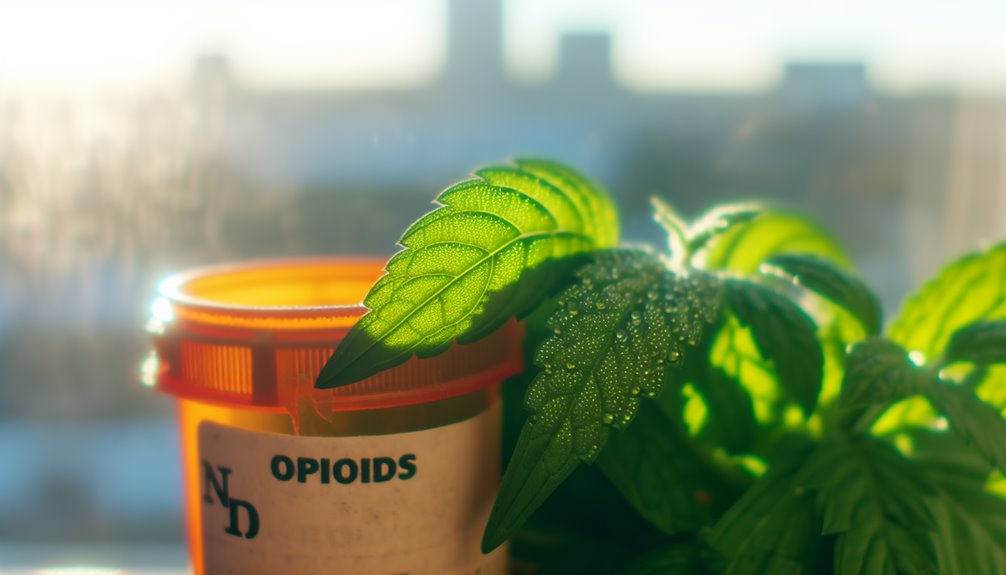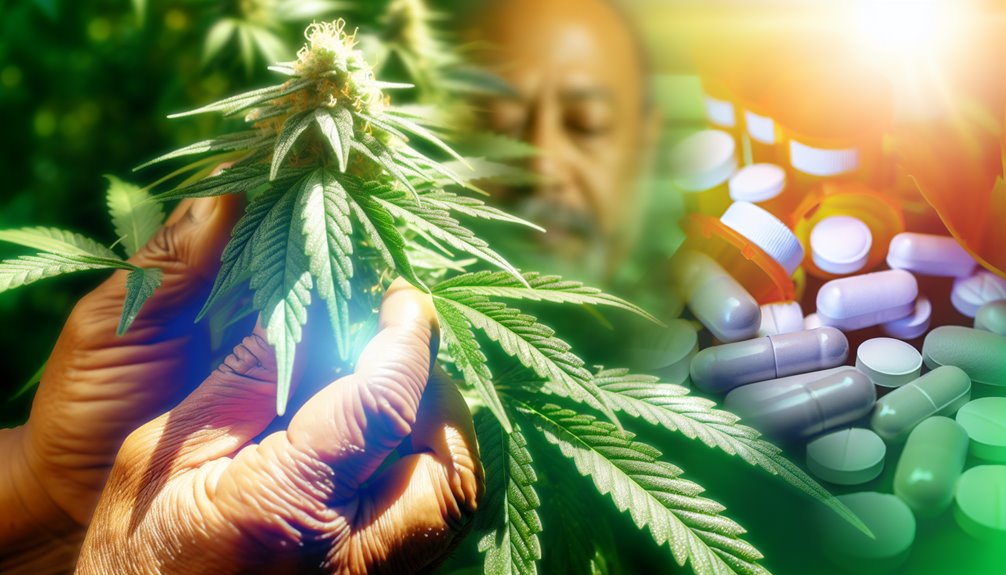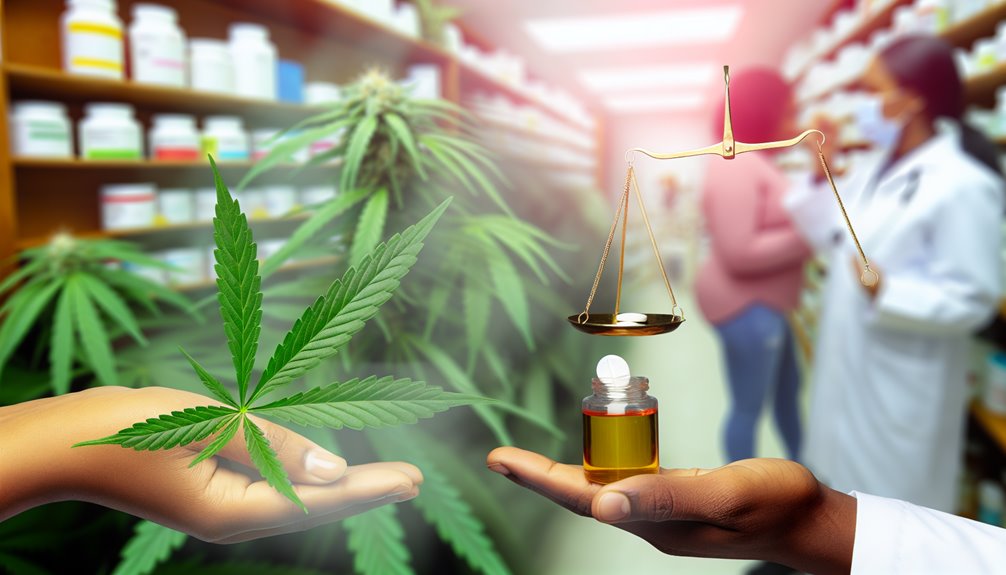Imagine living with chronic pain and relying on opioids for relief, only to find yourself dependent on these drugs. Now, consider a potential solution in the form of medical marijuana. Studies suggest that cannabis can not only reduce opioid usage, but also decrease associated side effects and overdose fatalities. But how does this possible alternative stack up against conventional treatment? Let's investigate the scientific evidence, legal hurdles, and future prospects of medical marijuana as an opioid substitute.
Understanding the Opioid Crisis: A Global Perspective

While the opioid crisis might seem like a distant issue, it's a global catastrophe that's impacting millions of people, no matter where they live. The global opioid statistics are staggering; the U.S., representing only 5% of the global population, consumes about 80% of the world's opioids. Yet, this crisis isn't confined to America. In Canada, opioid toxicity deaths and emergency department visits continue to rise, while the UK sees an alarming increase in opioid-related fatalities and long-term prescription use. The international response to this crisis is now more critical than ever. It's heartbreaking to see the economic and human cost, with lost productivity, healthcare burdens, and most tragically, lost lives. You're needed in this fight against opioid dependence. In America alone, over 153 million opioid prescriptions were issued in 2022, highlighting the depth and gravity of the issue (153 million opioid prescriptions).
The Science Behind Medical Marijuana
Diving into the science behind medical marijuana, it's essential to understand the four key areas of research: basic science and preclinical research, clinical trials and health outcomes, mechanisms and signaling systems, and epidemiological and population studies. In basic science, you'll find the study of cannabinoid chemistry, which helps in developing new compounds with potential therapeutic mechanisms. In clinical trials, the focus is on evaluating health outcomes, particularly in reducing opioid reliance. The signaling systems show us how cannabinoids and opioids interact in the body, giving insights for pain and dependency management. Finally, epidemiological studies help examine the societal effects of medical marijuana use, measuring its impact on opioid overdose rates at a population level. At the Penn State Medical Marijuana Academic Clinical Research Center (ACRC), over 30 researchers are engaged in these areas of study, working on both basic and clinical science divisions to advance our understanding of medical marijuana's therapeutic properties over 30 researchers.
Medical Marijuana vs. Opioids: A Comparative Analysis

Given the escalating opioid crisis, the potential of medical marijuana as an alternative treatment is being increasingly explored. Research indicates significant medical cannabis benefits, such as a considerable reduction in opioid use for chronic pain treatment. Long-term cannabis use can reduce daily opioid dosages by nearly half. In addition, it's associated with fewer adverse events than opioids, contributing to improved mental health outcomes. It's equally effective in pain relief and shows similar results in physical functioning and sleep quality. Access to medical cannabis is linked with lower opioid overdose mortality rates, highlighting its potential role in opioid reduction strategies. In understanding these benefits, you can contribute to shaping a healthier, more compassionate approach to pain management.
Case Studies: Medical Marijuana in Pain Management
Analyzing various case studies reveals the efficacy of medical marijuana in pain management. Patient experiences indicate that medicinal cannabis can markedly reduce pain scores in chronic non-cancer conditions like neuropathy, fibromyalgia, and rheumatoid arthritis. This effectiveness extends to nabiximols and other cannabinoids too. Notably, medical cannabis usage also culminates in a marked reduction in opioid dosage, reflecting its potential in combating opioid dependence. However, it's important to recognize that not all pain conditions respond favorably to cannabis. For instance, fibromyalgia patients report mixed outcomes, and the interaction between THC and CBD can be complex. Consequently, while the promise is evident, further research is needed to establish ideal dosing and long-term effects. Remember, the goal is enhancing patient quality of life while ensuring safety.
Exploring the Therapeutic Potential of Cannabis

While we've already seen the significant role of medical marijuana in pain management, it's equally essential to explore its broader therapeutic potential. Cannabis has shown efficacy in various therapeutic applications, such as alleviating chronic pain and muscle spasticity, controlling seizures, and stimulating appetite. Importantly, cannabinoids interact with the endocannabinoid system, modulating pain and mood, potentially reducing opioid need. Yet, dosage challenges persist due to lack of standardization in smokable and edible forms. As medical cannabis becomes increasingly legalized, clinical trials are ongoing to establish its benefits and determine appropriate dosages. Your role in understanding and maneuvering through these developments is vital, as it could potentially contribute to reducing opioid dependence.
The Role of Medical Marijuana in Opioid Dependence Treatment
Delving into the role of medical marijuana in opioid dependence treatment, it's vital to note the varying effects it has shown in managing withdrawal symptoms and cravings. Some studies suggest that cannabis therapy can reduce these symptoms and cravings, while others report inconsistent results. Medical marijuana's impact on opioid consumption is also significant, with some evidence indicating a reduction in opioid prescriptions where it is legalized. However, the overall effect remains modest. Regarding treatment adherence, findings are mixed. Some patients have shown improved adherence with intermittent cannabis use, while others haven't. It's important to remember, though, that medical marijuana presents its own risks, such as an increased risk of opioid misuse and other substance use disorders. This calls for careful withdrawal management and monitoring.
Legal and Regulatory Considerations for Medical Marijuana

Maneuvering the complex landscape of medical marijuana laws requires a deep understanding of both federal and state regulatory frameworks. Despite being classified as a Schedule I substance under the Controlled Substances Act, medical cannabis is used legally in several states. Federal law supersedes state law, but enforcement varies. Patient protections are key, with state laws allowing for the use of medical cannabis for specific conditions. Regulatory authorities, often health departments, oversee medical cannabis and must implement programs effectively. Licensing and compliance are also critical. Commercial cannabis activity requires specific licenses. Patient access and protections are paramount, with adults 18+ able to possess and cultivate cannabis following a physician's recommendation. Always remember, the aim is patient well-being.
Future Prospects: Medical Marijuana as an Opioid Alternative
As we explore the future prospects of medical marijuana as an opioid alternative, it's important to highlight some significant findings. Studies suggest that medical cannabis can lead to a substantial reduction in opioid dosage. Patient experiences show significant pain relief and a reduced reliance on opioids when using medical cannabis. However, concrete dosage guidelines are lacking and more research is needed to understand the long-term effects. The decision to use medical cannabis should be patient-driven, allowing individuals to evaluate its effectiveness for their unique circumstances. Although promising, remember that the reductions in opioid use are often modest and limited to high-risk cannabis users. Consequently, medical cannabis should be considered a harm reduction tool, not a universal solution.
Conclusion
You've witnessed the opioid crisis's devastating impact and the hopeful promise of medical marijuana. It's a stark contrast, isn't it? On one hand, opioids, with their addiction risk and fatal overdoses; on the other, cannabis, potentially reducing opioid dependence and offering pain relief with fewer side effects. As you consider this, imagine a future where medical marijuana is a standardized, legal alternative to opioids. Isn't it a future worth pursuing?
If you're curious to learn more about how medical marijuana can be a compassionate alternative for pain management, I warmly invite you to visit Fells Point Cannabis Docs of Maryland. Their knowledgeable team is ready to answer your questions and guide you through the process. You can also give them a call at (410) 401-4200. Exploring your options has never been easier, and who knows? This could be the step toward a brighter, healthier future for you or a loved one!
